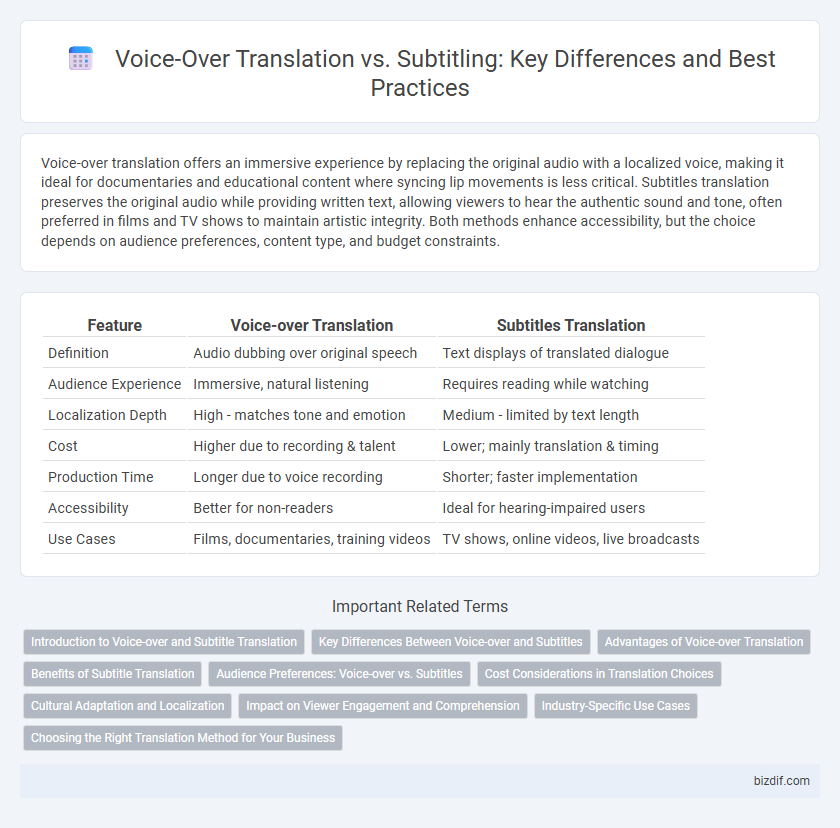Voice-over translation offers an immersive experience by replacing the original audio with a localized voice, making it ideal for documentaries and educational content where syncing lip movements is less critical. Subtitles translation preserves the original audio while providing written text, allowing viewers to hear the authentic sound and tone, often preferred in films and TV shows to maintain artistic integrity. Both methods enhance accessibility, but the choice depends on audience preferences, content type, and budget constraints.
Table of Comparison
| Feature | Voice-over Translation | Subtitles Translation |
|---|---|---|
| Definition | Audio dubbing over original speech | Text displays of translated dialogue |
| Audience Experience | Immersive, natural listening | Requires reading while watching |
| Localization Depth | High - matches tone and emotion | Medium - limited by text length |
| Cost | Higher due to recording & talent | Lower; mainly translation & timing |
| Production Time | Longer due to voice recording | Shorter; faster implementation |
| Accessibility | Better for non-readers | Ideal for hearing-impaired users |
| Use Cases | Films, documentaries, training videos | TV shows, online videos, live broadcasts |
Introduction to Voice-over and Subtitle Translation
Voice-over translation involves recording a translated audio track that synchronizes with the original video, enabling viewers to listen to the content in their native language. Subtitle translation requires converting spoken dialogue into written text displayed on screen, allowing audiences to read translations while watching the video. Both methods enhance accessibility and engagement, with voice-over being preferred for immersive experiences and subtitles favored for preserving original audio and reducing production costs.
Key Differences Between Voice-over and Subtitles
Voice-over translation replaces the original audio with a localized voice, allowing viewers to hear the content in their native language, while subtitles provide on-screen text that translates the spoken dialogue without altering the audio. Voice-over maintains the emotional tone through vocal expression, whereas subtitles focus on preserving accuracy and readability within limited screen space. Timing and synchronization are critical for both methods, with voice-over requiring precise lip-syncing and subtitles needing clear, concise phrasing to ensure viewer comprehension.
Advantages of Voice-over Translation
Voice-over translation enhances viewer engagement by delivering content in the audience's native language with synchronized audio, creating a more immersive experience than subtitles. It facilitates better accessibility for individuals with reading difficulties or those multitasking, as viewers can listen without diverting attention to text. Voice-over also preserves the emotional tone and nuances of the original dialogue, improving comprehension and audience connection.
Benefits of Subtitle Translation
Subtitle translation enhances accessibility by allowing audiences to understand foreign content without altering the original audio, preserving the authenticity of performances. It supports multilingual reach, enabling content to be enjoyed by diverse language speakers simultaneously while remaining cost-effective compared to voice-over production. Subtitles also improve SEO for video platforms by increasing keyword relevance and viewer engagement through text-based metadata.
Audience Preferences: Voice-over vs. Subtitles
Audience preferences between voice-over translation and subtitles vary significantly based on viewing habits and cultural context. Voice-over translation offers a more immersive experience by synchronizing speech with original actors' emotions, favored in regions like Eastern Europe and Latin America. Subtitles are preferred in markets such as Scandinavia and the Netherlands, where audiences value original audio authenticity and quick language comprehension without distracting from visuals.
Cost Considerations in Translation Choices
Voice-over translation generally incurs higher costs due to the need for professional voice actors, studio time, and audio editing, while subtitles translation typically requires lower expenses limited to text translation and timing synchronization. The choice between these methods often depends on budget constraints and the target audience's preferences for accessibility and engagement. Considering long-term use, subtitles provide a cost-effective solution for multilingual content distribution, whereas voice-over offers enhanced viewer immersion at a premium price.
Cultural Adaptation and Localization
Voice-over translation enhances cultural adaptation by matching vocal tone and emotion to the target audience's cultural context, creating a more immersive experience. Subtitles translation requires precise localization to convey idiomatic expressions and cultural references concisely within limited screen space. Effective localization strategies in both voice-over and subtitles ensure content resonates authentically with diverse audiences across languages.
Impact on Viewer Engagement and Comprehension
Voice-over translation enhances viewer engagement by preserving the original audio's emotional tone, making content more immersive and accessible to audiences with varying literacy levels. Subtitles translation supports comprehension by providing precise, written dialogue that maintains linguistic nuances, benefiting viewers in noisy environments or those learning the language. Balancing voice-over and subtitles depends on target audience preferences and content type to maximize retention and emotional connection.
Industry-Specific Use Cases
Voice-over translation is preferred in e-learning and corporate training for its ability to maintain engagement and clarity while overcoming language barriers in technical instructions. Subtitles translation excels in media distribution, such as films and documentaries, where preserving original audio and accommodating diverse languages is crucial. Both techniques are essential in global marketing campaigns, with voice-over enhancing product demonstrations and subtitles ensuring accessibility across international audiences.
Choosing the Right Translation Method for Your Business
Selecting the appropriate translation method depends on your business goals, target audience, and content type. Voice-over translation enhances viewer engagement through natural speech, ideal for marketing videos and training materials. Subtitles translation offers cost-effective accessibility and preserves original audio, making it suitable for international films and webinars.
Voice-over Translation vs Subtitles Translation Infographic

 bizdif.com
bizdif.com